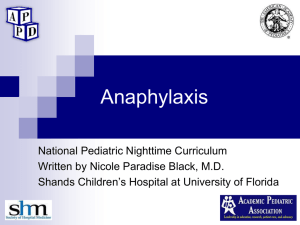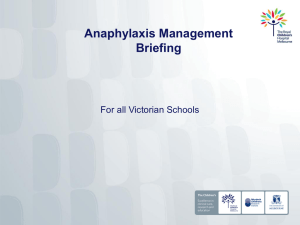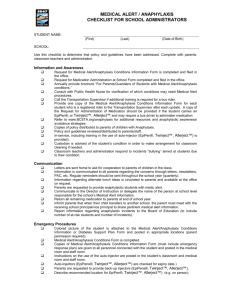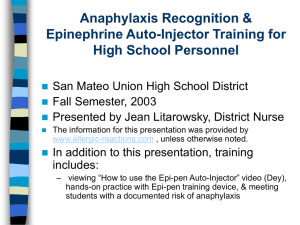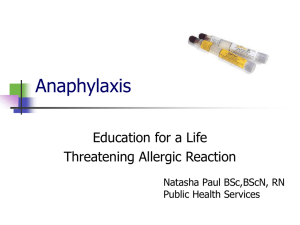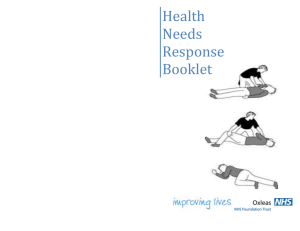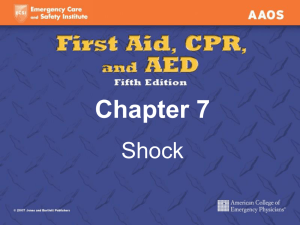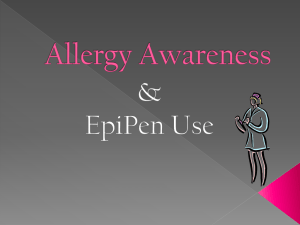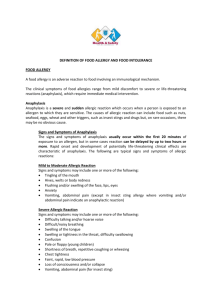2014 EPS - Anaphylaxis Policy
advertisement
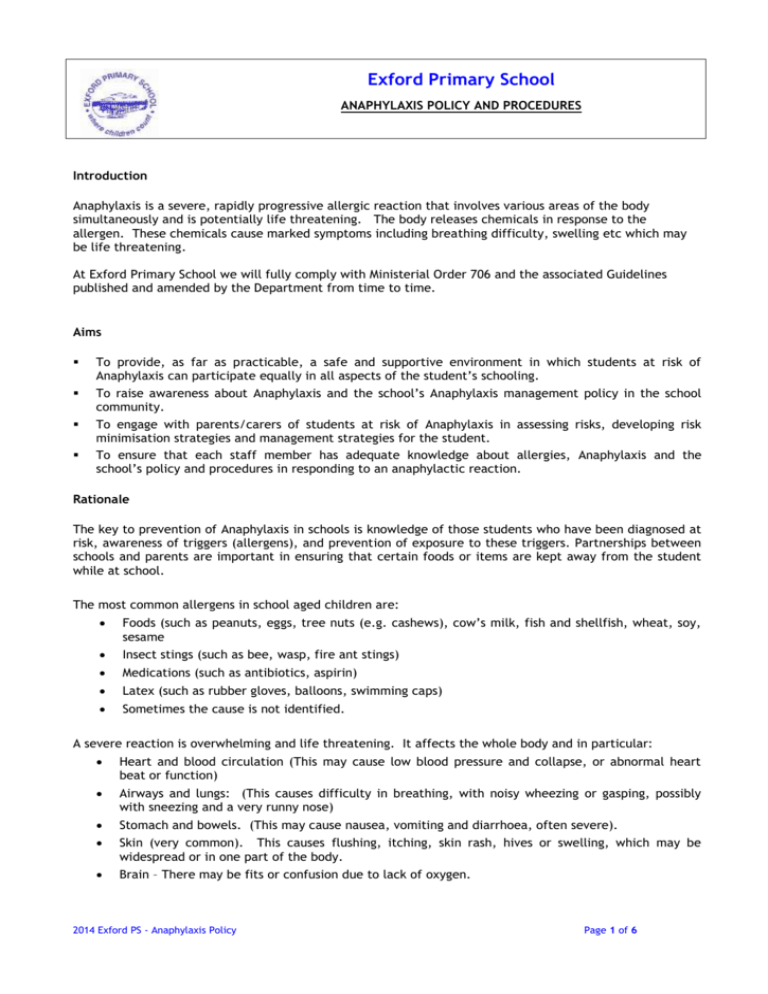
Exford Primary School ANAPHYLAXIS POLICY AND PROCEDURES Introduction Anaphylaxis is a severe, rapidly progressive allergic reaction that involves various areas of the body simultaneously and is potentially life threatening. The body releases chemicals in response to the allergen. These chemicals cause marked symptoms including breathing difficulty, swelling etc which may be life threatening. At Exford Primary School we will fully comply with Ministerial Order 706 and the associated Guidelines published and amended by the Department from time to time. Aims To provide, as far as practicable, a safe and supportive environment in which students at risk of Anaphylaxis can participate equally in all aspects of the student’s schooling. To raise awareness about Anaphylaxis and the school’s Anaphylaxis management policy in the school community. To engage with parents/carers of students at risk of Anaphylaxis in assessing risks, developing risk minimisation strategies and management strategies for the student. To ensure that each staff member has adequate knowledge about allergies, Anaphylaxis and the school’s policy and procedures in responding to an anaphylactic reaction. Rationale The key to prevention of Anaphylaxis in schools is knowledge of those students who have been diagnosed at risk, awareness of triggers (allergens), and prevention of exposure to these triggers. Partnerships between schools and parents are important in ensuring that certain foods or items are kept away from the student while at school. The most common allergens in school aged children are: Foods (such as peanuts, eggs, tree nuts (e.g. cashews), cow’s milk, fish and shellfish, wheat, soy, sesame Insect stings (such as bee, wasp, fire ant stings) Medications (such as antibiotics, aspirin) Latex (such as rubber gloves, balloons, swimming caps) Sometimes the cause is not identified. A severe reaction is overwhelming and life threatening. It affects the whole body and in particular: Heart and blood circulation (This may cause low blood pressure and collapse, or abnormal heart beat or function) Airways and lungs: (This causes difficulty in breathing, with noisy wheezing or gasping, possibly with sneezing and a very runny nose) Stomach and bowels. (This may cause nausea, vomiting and diarrhoea, often severe). Skin (very common). This causes flushing, itching, skin rash, hives or swelling, which may be widespread or in one part of the body. Brain – There may be fits or confusion due to lack of oxygen. 2014 Exford PS - Anaphylaxis Policy Page 1 of 6 Usually several parts of the body are affect and the child will feel extremely unwell. It is important to act quickly to treat a severe allergic reaction. Initial symptoms may appear within a few seconds, or up to several hours after exposure: Symptoms of an allergic reaction include: Tingling of the mouth Swelling of lips, eyes and face. Hives, body rash, itching. Symptoms of a severe allergic reaction (Anaphylaxis): Difficult and/or noisy breathing Wheeze or persistent cough Difficulty talking or hoarse voice Swelling of the tongue, lips, throat and possibly hands and feet Nausea, vomiting, severe abdominal cramps Loss of consciousness and/or collapse Pale and floppy (in young children). Adrenaline given through an EpiPen® auto-injector to the muscle of the outer mid-thigh is the most effective First Aid treatment for Anaphylaxis. It shrinks abnormally wide blood vessels and makes the heart beat strongly, It helps improve very low blood pressure and poor circulation that result from the allergic reaction. It also relaxes the lungs to ease breathing and lessens wheezing, It helps stop swelling, skin rash, itching. Prompt administration of the Epipen is crucial in a severe allergic emergency. Consult the child’s Individual Anaphylaxis Action Plan. As an Epipen is prescribed for that particular child and is a prescription based on body weight, it is important that each child’s own Epipen is administered to them. DO NOT administer another child’s Epipen to a student unless there is no Epipen available and there is an emergency with the child. When the Epipen is injected into the upper thigh, count to 10 before removing from the skin. The student will require immediate medical attention for ongoing treatment. In cases of upper airway obstruction and hypertension, it is critical that the student is admitted to hospital as rebound Anaphylaxis may occur after initial treatment. Follow-up Actions: Call a M.I.C.A. Ambulance (Dial 000). Give name, address, location and medical condition “Anaphylaxis”. State you have used the epi-pen and at what time. Advise the child’s parents Implementation Implementation Responsibilities Parents will be responsible for: Providing an Individual Anaphylaxis Action Plan (from Australasian Society of Clinical Immunology and Allergy - ASCIA) for their child. This plan must have been developed in consultation with a medical practitioner. The ASCIA Anaphylaxis Action Plan proforma can be downloaded from: www.education.vic.gov.au/healthwellbeing/health/Anaphylaxis.htm It is the responsibility of the parent to: 2014 Exford PS - Anaphylaxis Policy Page 2 of 6 provide the emergency procedures plan (Australian Society of Clinical Immunology and Allergy (ASCIA) Action Plan) Inform the school if the child’s medical condition changes, and if relevant provide an updated emergency procedures plan (ASCIA Action Plan) when the plan is provided to the school and when it is reviewed. Providing information at the time of enrolment about their child’s allergies and if needed, an Individual Anaphylaxis Action Plan for their child. Providing one EpiPen for school use. Recording the expiry date of medications placed at school and ensuring the timely replacement of those medications/Epipens. Informing the school if their child’s medical condition changes, and if relevant, providing an updated Individual Anaphylaxis Action Plan. - The ASCIA Individual Anaphylaxis Action Plans provided by parents will: Contain detailed information about diagnosis; including the type of allergy or allergies the students has, based on diagnosis by the medical practitioner. Provide strategies to minimise the risk of exposure to allergens while the student is under care / supervision of school staff, for in-school and out of school setting such as camps, special events days and excursions. Contain a current photo of the student Contain current parent emergency contact phone numbers Provide an explanation of symptoms and directions for action should a reaction occur Be signed by a medical practitioner who is treating the child on the date of signing the emergency procedure plan. The student’s individual management plan will be reviewed, in consultation with the student’s parents/carers: - annually, and as applicable - if the student’s condition changes - immediately after a student has had an anaphylactic reaction at school The school will ensure that: Individual Anaphylaxis Action Plans are displayed in the First Aid room. A copy of Individual Anaphylaxis Action Plans will be attached to each enrolment record, placed in the Serious Illness Register (First Aid office) and if appropriate included in the camp health documents folder. Individual Anaphylaxis Action Plans are reviewed in consultation with parents/ carers annually, if conditions change or immediately after a student has an anaphylactic reaction at school. The First Aid Coordinator updates school First Aid records in accordance with action plans annually or if conditions changes or a reaction occurs. Each child has their own Epipen located in their classroom. The Casual Relief Teacher (CRT) folder informs CRTs of students at risk of Anaphylaxis in their class and provides information on the procedures for dealing with an anaphylactic reaction within classrooms/ buildings and out in the yard. At risk students who are under the care or supervision of the school during Yard Duty, excursions, camps and special events, are provided with a sufficient number of staff present who have current training in Anaphylaxis management. An EpiPen is carried by school staff on excursions, outings and camps for each student with an Individual Anaphylaxis Action Plan and the EpiPen is accessible to the adult who is responsible for or accompanying the child during the activity. School staff are trained in Anaphylaxis risk assessment and management as soon as practicable from the start of the school year and participate in an update in Semester 2. An interim plan is made for any new students enrolled, developed in conjunction with parents and to be replaced by an Individual Anaphylaxis Action Plan (ASCIA) developed with their doctor and returned to the First Aid officer within a week of enrolment. 2014 Exford PS - Anaphylaxis Policy Page 3 of 6 Induction for new staff will include Anaphylaxis awareness information and appropriate training will be sought as soon as possible for new staff. A school communication plan is in place providing current information for all staff, students and parents about Anaphylaxis. The communication plan includes information about what steps will be taken to respond to a student’s anaphylactic reaction in a classroom, in the yard, on a school excursion, camp and special event day. Volunteers and casual relief staff will be informed of students at risk of Anaphylaxis and their role in responding to an anaphylactic reaction by a student in their care by staff members. Staff are briefed once a semester on: - school’s Anaphylaxis management policy - the causes symptoms and treatment of Anaphylaxis - the identities of students diagnosed at risk of Anaphylaxis and where their medication is stored - how to use an EpiPen (auto adrenaline injecting device) - The school’s First Aid procedures and each student’s Anaphylaxis Action Plan procedures when responding to an anaphylactic reaction. Epipen of children identified by Individual Anaphylaxis Action Plans are kept in individual bags / containers that are colour coded and clearly labelled. The bags/containers are kept in the child’s classroom in a clearly identified cupboard. School staff will follow these prevention strategies: Know student/s in their class or classes who are at risk and be familiar with their individual management plans and have up to date training in Anaphylaxis management. Have regular discussions with students about the importance of washing hands, eating their own food and not sharing food with others. Send parent permission notices home to all parents about classroom or school activities that may pose a risk to students with Anaphylaxis, for example hatching chicken eggs. Know where medication for at risk students is stored and how to use it. Staff Communication and Training The Principal will be responsible for ensuring that a communication plan is developed to provide information to all staff, students and parents about Anaphylaxis and the school’s Anaphylaxis management policy. The communication plan will include information about what steps will be taken to respond to an anaphylactic reaction by a student in a classroom, in the school yard, on school excursions, on school camps and special event days. Teachers and other school staff who conduct classes with students at risk of Anaphylaxis or attend to or give instruction to students at risk of Anaphylaxis must have up to date training in an Anaphylaxis management training course. All staff will be briefed once each semester by a staff member who has up to date Anaphylaxis management training on: - the schools Anaphylaxis management policy - the causes, symptoms and treatment of Anaphylaxis - the identities of students diagnosed at risk of Anaphylaxis and where their medication is located - how to use an auto adrenaline injecting device - the school’s First Aid and emergency response procedures At times when the student is under the care or supervision of the school, including excursions, Yard Duty, camps, and special event days, the principal shall ensure that there is a sufficient number of staff who have had up-to-date training in an Anaphylaxis management training course. 2014 Exford PS - Anaphylaxis Policy Page 4 of 6 Communicating Risk Management Guidelines The school will have a Communication Plan to raise staff, students and school community awareness about Anaphylaxis, severe allergies and the following school rules: - Children must not share food at any time - Parents and families must see the class teacher before bringing a birthday cake of lolly bags to school. - Parents should not give food treats to children in the playground - Parents and families should never give food to another person’s child unless prior arrangement has been made between the parents - In the case where a child does bring peanut products to school, the child will be isolated from the remainder of the children, face and hands are washed before returning to their class group. Evaluation The Anaphylaxis policy and management procedures will be monitored and reviewed regularly by the Assistant Principal, the First Aid Coordinator and class teacher in conjunction with the parents of the students with Individual Anaphylaxis Action Plans. This policy will also be reviewed as part of the school’s regular policy review process. 2014 Exford PS - Anaphylaxis Policy Page 5 of 6 2014 Exford PS - Anaphylaxis Policy Page 6 of 6
